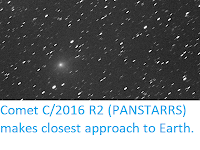Comet C/2015 O1 (PANSTARRS) makes its closest approach to the Earth
on Thursday 5 April 2018 reaching a distance of 3.23 AU from
the
Earth
(3.23 times as far from us as the Sun, or 483 687 000 km). At this
distance the comet will not be naked eye visible, having a magnitude of
14.34, which means it would require a good telescope to observe it, and
then preferably in the Northern Hemisphere, as it is currently
in the
constellation of Bootes, which cannot be seen clearly from to far south of the
Equator.
Comet C/2015 O1 (PANSTARRS), imaged on 19 February 2018. Comet is small object at centre of image with a faint tail. The elongate objects
are stars, with the elongation being caused by the long exposure needed
to take the photograph. Line crossing image is a satelite. Roland Fichtl/Seiichi Yoshida.
C/2015 O1 (PANSTARRS) was discovered on 19 July 2015 by the University of Hawaii's PANSTARRS telescope. The name C/2015 O1 (PANSTARRS) implies that it is a non-periodic comet (C/) (all comets are, strictly speaking, periodic since they all orbit the Sun, but those with periods longer than 200 years are considered to be non-periodic), that it was the first comet (comet 1) discovered in the second half of July 2015 (period 2015 O) and that it was discovered by the PANSTARRS telescope.
The orbit of C/2015 O1 (PANSTARRS) at its closest to the Earth. Heavens Above.
C/2015 O1 (PANSTARRS) has an estimated orbital period of 7 181 700 years and a highly eccentric orbit tilted at an angle of 127.2° to the plain of the Solar System, that brings it to 3.73 AU from the Sun at perihelion (373% of the distance between the Earth and the Sun, considerably outside the orbit of Mars); to 74 442 AU from the Sun at aphelion (74 442 times as far from the Sun as the Earth or 2550 times as far from the Sun as the planet Neptune), reaching the central part of the Oort Cloud.
See also...
Follow Sciency Thoughts on Facebook.








